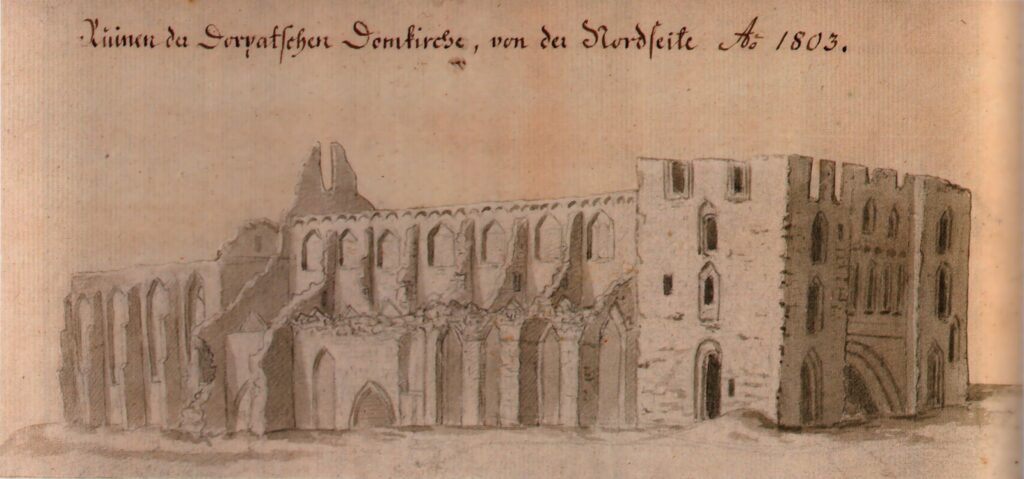KP7
EST:
Tartu toomkirik
Pildiallkiri: Vaade toomkiriku varemetele põhjaküljelt 1803. aastal
Võimalik autor: Eduard Philipp Körber (Läti Ülikooli Akadeemiline Raamatukogu).
Vana-Liivimaa suurima katedraali ehitust alustati 13. sajandil ja see kestis etappide kaupa 15. sajandi lõpuni. Avar kooriosa valmis 1470. aastatel, paarkümmend aastat hiljem lisandus läänefassaad kahe võimsa torniga, mille esialgne kõrgus võis ületada tänapäevast lausa kolm korda.
Oma hiilgust kirik pikka aega nautida ei saanud. 1525. aastal rüüstati reformatsiooniaegsete rahutuste käigus hoonet ja ümberkaudseid elamuid. Esialgu jätkas toomkirik pühakojana tegutsemist, kuid 16. sajandi teisel poolel toimunud Liivi sõja ajal kahjustati hoonet märkimisväärselt ja järgnevatel sajanditel jäi see varemetesse.
1803.–1806. aastal muudeti toomkiriku varemete kooriosa arhitekt Johann Wilhelm Krause kavandite järgi ülikooli raamatukoguks. Kõrvuti seati uus ja vana, väärtustades nii keskaegset arhitektuuri kui ka klassitsistlikke kujunduselemente. Raamatukogu töötas majas 1981. aastani, pärast mida asus sinna Tartu Ülikooli muuseum.
ENG:
Tartu Cathedral
View of the cathedral ruins from the north in 1803
Possible author: Eduard Philipp Körber (Academic Library of the University of Latvia)
The construction of the largest cathedral in Old Livonia began in the 13th century and continued in
stages until the end of the 15th century. The spacious choir section was completed in the 1470s, but
the western façade with the two mighty towers, which may have been three times as high as they
are today, was added a few decades later.
The church could not enjoy its grandeur for long. During the Reformation riots in 1525, the cathedral
and its surrounding houses were looted. Initially, the cathedral continued to function as a church.
Still, during the Livonian War in the second half of the 16th century, the building suffered extensive
damage and was left in ruins in the following centuries.
From 1803 to 1806, the choir section of the cathedral ruins was converted into the university library
according to the designs of architect Johann Wilhelm Krause. The new and the old were set side by
side, appreciating both the medieval architecture and the Classicist design elements. The library
worked in the building until 1981; after that, the University of Tartu Museum moved in.



